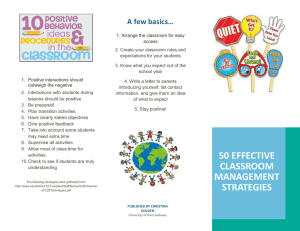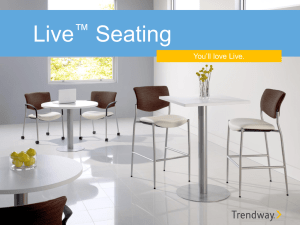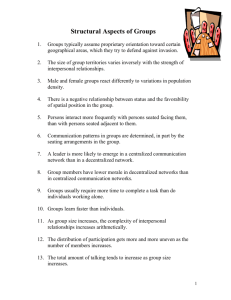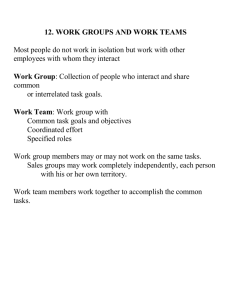Document
advertisement
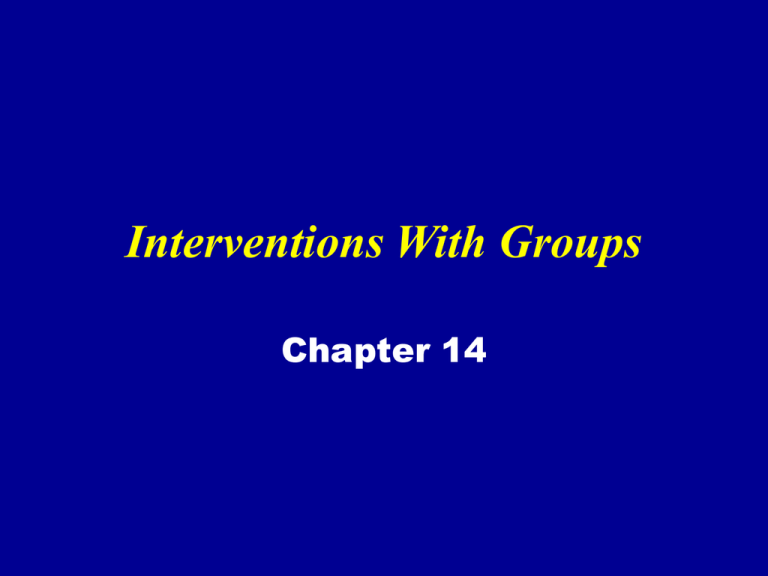
Interventions With Groups Chapter 14 Definitions of “Group” • A collection of individuals who identify with the leader, and other members, but who act independently (psychoanalytic definition) • Parts or components that exist to perform some activity or purpose (systems theory) • Two or more people who develop interactive relationships and share at least one common goal (this text) Open vs. Closed Groups • Open group – – – – New members may join. Members may leave at any time. New members are at a disadvantage. Advantage of this type is that group can continue. • Closed group – Members join at one time. – There are no replacement members. – Group is more cohesive. – Group is more likely to dissolve when members drop out. Group Size • Small • Large • Eight to 10 people • > 10 members • Cohesive • Can be therapeutic • Fewer subgroups • More cost-effective • Richer IP • Open-ended, ongoing • Led by one • Avoid intense transference and counter Group Development • Group development is a process. • Definition: Group process is the culmination of the session-to-session interactions of the members that move the group toward its goals. Group Process • Beginning • Honeymoon • Conflict • Working • Develop rules, rituals • Group realizes its purpose. • Termination • Members grieve for loss of the group. • Reestablish themselves as individuals Roles of Group Members • Formal group roles – Leader – Member • Informal group roles – Task – Maintenance – Individual Group Membership: Roles & Functions • Task roles: business of the group – Initiator, information seeker, coordinator, recorder • Maintenance roles: keeping group together – Harmonizer, compromiser, gate-keeper, observer • Individual roles: either detract or enhance group – Aggressor, self-confessor, recognition seeker Group Communication • Verbal Communication – Communication network • Sociometric analysis • Sit next to each other, talk to each other – Group themes – Mood Group Communication Non-verbal Communication • Seating arrangement • Eye contact • Posture • Body gestures Group Norms & Standards • Groups develop norms or acceptable group behaviors. • Formalized norms – Example: beginning group on time • Informal norms Group Cohesion • One of the goals is usually fostering group cohesion. • Encourages social interaction • Helps group stay together • Increases members commitment to group • Disadvantage: – In very cohesive groups, members are more likely to transgress personal boundaries. – Can become dysfunctional Groupthink • Tendency of groups to avoid conflict and adopt a normative pattern of thinking • Can lead to poor decision-making because the group is more concerned about being part of the group, rather than thinking independently • Unclear whether cohesive groups are more likely to experience groupthink • Be aware of the possibility in decision-making groups Leading a Group • Obtains and receives information • Helps in the diagnosis of group goals, obstacles and consequences of decisions • Facilitates communication • Helps integrate the various perspectives and alternative possibilities • Tests and evaluates proposals and decisions • Techniques Table 14-3 Leadership Skills • Listening • Tracking verbal and nonverbal interactions • Maintaining a neutral, nonjudgmental style • Not showing preference to one member over another • Providing everyone with an opportunity to contribute Choosing Leadership Styles • Led within the context of the group leader’s theoretical background • Direct-indirect Continuum – Direct leadership • Controls the interaction • Gives direct information • Allows little discussion – Indirect leadership • Uses reflection and offers little guidance • Does not provide information to the group Selecting Group Members • Leader responsible for membership • Consider the following: – Does the purpose of group match the need of patient? – Does the patient have the skills to participate in the group? – Will other group members accept the new member? – Will the new member be able to make the commitment to attend? Seating Arrangements • Use circle seating without barriers (tables). • Rectangular tables tend to promote positions of power at the end of the table. • Classroom seating prevents effective interactions. • No one should sit outside the circle. Seating Arrangements • Members who sit closest to the leader are more likely to have more power. • Group should be held in a quiet, pleasant room with adequate space and privacy. • Large rooms inhibit communication. • Avoid eating during group. Discussion of Challenging Behaviors • Monopolizer • “Yes, but” • Disliked member • Group conflict Types of Groups • Psychoeducation – Task groups – Teaching groups • Supportive therapy groups • Psychotherapy groups • Self-help groups Nursing Intervention Groups • Medication groups (Text Box 14.2) • Symptom management groups • Anger management groups • Self-care groups

